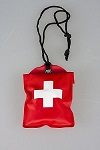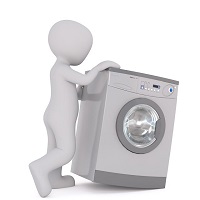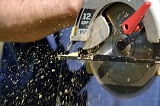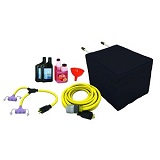

 When choosing a portable generator first take a few minutes and truly think about how you plan to use your new generator. If you need a generator for your camping trip where you just need some lights, a fan, the coffee pot, your radio or portable TV and to charge your cell phone a small quiet portable inverter generator should fit your needs.
When choosing a portable generator first take a few minutes and truly think about how you plan to use your new generator. If you need a generator for your camping trip where you just need some lights, a fan, the coffee pot, your radio or portable TV and to charge your cell phone a small quiet portable inverter generator should fit your needs.
 If you are a contractor of some type and you constantly work a lot on job sites that do not yet have power from the utility company, and you need power to run your power tools, then you too should find that one of the small to medium size portable generators will meet your needs. They are easy to transport yet provide enough power to drive tools like drills, skill saws, hammer guns, etc.
If you are a contractor of some type and you constantly work a lot on job sites that do not yet have power from the utility company, and you need power to run your power tools, then you too should find that one of the small to medium size portable generators will meet your needs. They are easy to transport yet provide enough power to drive tools like drills, skill saws, hammer guns, etc.
 If you have someone in your household that is using some type of medical equipment that they really can't be without for a period of time then you may choose to keep a generator as backup power for this equipemnt until your electrical power can be restored. Maybe you have a family member that requires oxygen and that equipment requires electrical power then a small portable generator is almost an essential item to have on hand for alternative power.
If you have someone in your household that is using some type of medical equipment that they really can't be without for a period of time then you may choose to keep a generator as backup power for this equipemnt until your electrical power can be restored. Maybe you have a family member that requires oxygen and that equipment requires electrical power then a small portable generator is almost an essential item to have on hand for alternative power.
If you are interested in home generators for power outages then you have more power needs to consider when selecting a portable generator. Stay with us and we will show you how to calculate your power consumption and select the right portable generator for your needs.
What Wattage Do You Need?
Unless you are an electrician you probably don't put a whole lot of thought into how much power an electrical device is using, because your utility company has provided an adequate supply of power to your house for all your needs.
However portable generators not only come in different physical sizes they come in different sizes when it comes to the amount of power they generate for you to use.
So, let's take a look at what you want to power with your generator and figure out how much wattage that requires.
Running Watts / Startup Watts
Be aware that some electrical appliances need more watts to start up than they need to run (reactive loads) and others need the same amount to both start up and to run (resistive loads).
Many reative loads are involved in heating or making heat of some kind. For example, Coffee maker, Toaster or Light bulbs.
Reactive loads contain an electric motor, which requires additional power to start, but significantly less power to run once it gets going. Typically starting power is three times the amount of power to run the appliance. Some examples are: Refrigerators, Freezers, Power tools, Air conditioners, Air compressors, Furnace fans, Well pumps. Some household appliances, like a refrigerator or furnace, have internal fans that come on intermittently. Extra wattage is needed to start the fan each time. Refrigerators also have a defrost cycle that requires power in addition to the compressor and fans which turn on intermittently.
If you are going to use your generator to power your work tools then be aware that a lot of these tools are reactive load type devices. For instance, whan a saw begins cutting wood, its power requirement will increase.
If you are sizing a generator for your household power backup then understand that a microwave oven may be marked "1100 watt oven" whice means that it will produce 1100 watts of cooking power, but it will require more than that from a generator to run.
 Most electric motors and appliances list their power requirements in amps. You can usually find these Amp requirements on the nameplate or a stamp on the bottom or side of the appliance. A data tag is found on all electric motors.
Most electric motors and appliances list their power requirements in amps. You can usually find these Amp requirements on the nameplate or a stamp on the bottom or side of the appliance. A data tag is found on all electric motors.
On the data tag you should find volts, amps, phase, cycle, hp and sometimea a code for the electrical motor.
To convert amps to watts multyply volts x amps.
What Are You Planning To Power With YOUR Generator?
If you are going to be using your generator for camping or to carry to a worksite to power your work tools or equipment then you won't have a very long list of items to calculate your wattage needs.
However, if you need a generator for your RV or as backup power in your home during power outages your list will be a little longer..
You have seen above how to calculate the wattage requirement of each item that you want to power from a generator.
Consumer Reports Power Estimation Guide
If you don't want to hunt down all the tags on your electrical appliances and would like to just estimate your wattage needs then you can use the Consumer Reports Power Estimation Guide.
There is also this Wattage Estimation Guide that is located on the Honda site.
Do You Need It All?
November 20, 2025When calculating your wattage requirements, especially for your home, give some thought to what you really need. Most home power outgages last from a few hours to generally a max of a couple of weeks. Don't forget that most generators are fueled by either gasoline or propane fuel. You will want to consider not only the cost of this fuel but the availability and / or storage of enough fuel to get you through your outage.
So, do you really need the dishwasher during that time. Or, maybe you could have a clothes line and dry the clothes outside in the fresh air vs. using the clothes dryer.
If you have someone using critical medical equipment you will certainly want to power those items. You will want to preserve the food supply you have in your refrigerator and freezer. Maybe you can get by with fans and not use the central air conditioning unit.
There are whole house generators which are really nice to have but that may not be in your budget at this time. However, there are many reasonably priced portable generators on the market that can be used to save your food and give you some of the comforts of home during a power outage. You can always upgrade to a whole house one later when you can afford it.
Other Generator Features To Consider
More information will be provided about these features as we review the various generators.
One additional item for us to cover here is how to safely use your generator.
Portable genertors burn fuels that result in exhaust that contains carbon monoixde. Never operate a portable generator inside a garage, shed, tent, home or any other enclosed structure. Carbon monoxide levels can reach lethal levels in just minutes.
When running generators always place them away from home windows and doors, tents and sleeping spaces. A small opening can pull large amounts of exhaust into an enclosed space.
Also think about your neighbors while using a generator at home, or at a campsite. Position your generator where noise and exhaust won't be a factor for them also.
When refueling your generator turn it off and let it cool for a few minutes before adding fuel. While you have it off to add fuel is a good time to check the oil also.
Please proceed to the portable generator review group (Camping / Recreational) (Home / Emergencies) (Work Sites) that fits your needs at this time.
"This post may contain affiliate links for which I could receive a commission."
Departments
"This site contains affiliate links for which I may be compensated."Generators
Outdoor Gear
Furniture
Cooking
Power Tools
Plumbing Pumps




